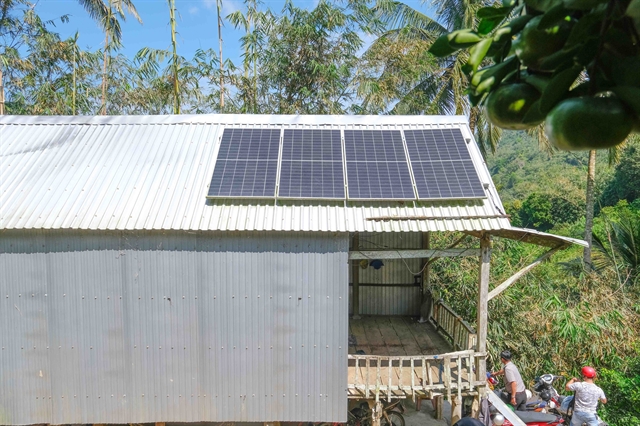 Society
Society

 |
| Solar panels are installed on the roof of a house in the tangerine garden of farmer Nguyễn Hữu Hạnh in An Giang Province’s Tịnh Biên District. — VNA/VNS Photo Thanh Liêm |
MEKONG DELTA — The application of a solar power model combined with agricultural production helps many farmers in Cửu Long (Mekong) Delta provinces become more proactive in production plans and reduce costs.
Farmer Nguyễn Hữu Hạnh, 45, is one of the pioneers of installing and using solar power in his 5,000sq.m garden in An Hảo Commune’s Vồ Bà Hamlet in An Giang Province’s Tịnh Biên District.
Hạnh said the hamlet had access to electricity from the national grid more than a year ago. However, most people use solar power because their houses are too far from the grid and the cost of getting electricity is high.
Many families getting electricity from the national grid still use solar power in parallel, he said.
Nearly 10 years ago, with financial support from the province’s Department of Agriculture and the Green Innovation Development Centre (GreenID), he installed solar panels on the roof of his house and the tangerine garden.
“Using solar power is safe, and helps protect the environment and reduce costs,” he said.
Before installing solar panels, he used about seven litres of oil every day to run a diesel engine for lighting and pumping water.
“Now I can save more than VNĐ3 million (US$122.5) per month. I have been using the panels for 10 years and they still work normally," he said.
Most of the local households in three hamlets in the commune are using solar power.
In the past, people here were very poor. Thanks to using solar power, people have developed a garden economy and improved their lives, he said.
Nguyễn Văn Mừng is also a pioneer in installing solar panels for his 8,000sq.m pepper garden.
He installed four solar panels on the roof of his house for running a solar-powered pump system and storing more than 500W of electricity each day.
Earlier, his family spent more than VNĐ300,000 ($12.3) every week on buying oil to pump water to irrigate his pepper garden.
Since solar power has been available, watering the pepper garden has always been proactive, reducing costs, he said.
“The pepper garden is fully watered, so every year my pepper always has a higher quality and is sold at a good price,” he said.
For last year's pepper crop, he harvested nearly 500kg and sold it at VNĐ150,000 - 250,000 ($6.1-10.2) depending on the type, but that was not enough to satisfy customer demand.
 |
| Farmer Nguyễn Hữu Hạnh using a solar-powered pump system to water his tangerine trees in An Giang Province's Tịnh Biên District. — VNA/VNS Photo Thanh Liêm |
Great potential
Nguyễn Văn Dũng, chairman of Farmers' Association of An Hảo Commune, said the three communes of Vồ Đầu, Vồ Bà, Thiên Tuế on the Cấm Mountain have 754 households with 2,735 people.
Nearly 100 per cent of households here have used solar power in daily life and production for more than 10 years.
“That helps them save production costs and increase income, contributing to economic development and environmental protection,” he said.
The models of Mừng and Hạnh are among more than 500 models of production development associated with high-tech agriculture throughout the province supported by the Department of Agriculture and Rural Development.
Nguyễn Sĩ Lâm, director of An Giang Province’s Department of Agriculture and Rural Development, said the province’s agriculture and rural development sector has supported the installation of four biogas tanks made of composite materials in Chợ Mới District from the support of Decision No. 50/2014/QD-TTg dated September 4, 2014 of the Prime Minister on policies to improve the efficiency of livestock farming in the period of 2015-20.
The department has also provided financial and technical support for 150 households to equip them with portable solar lamps, and 98 households to install solar panels with a capacity of 200Wp supported by GreenID, aiming to promote the economical and efficient use of energy.
An Giang has a lot of potential to develop solar power sources because it is located in an area with radiation intensity from 4.5 - 5.1 kWh per sq.m per day.
It has a high number of sunlight hours, with more than 2,400 hours per year.
According to the province’s Department of Industry and Trade, the province has great growth potential of solar power, with an additional capacity of about 3,500 MWp.
There is also potential for exporting electricity to neighbouring Cambodia.
Nguyễn Minh Hùng, director of the Department of Industry and Trade, said the replication of energy-saving solutions and models is extremely necessary in the context of unusual market developments in the energy sector.
“The model of using solar panels combined with agricultural production is a meaningful solution that needs to be encouraged and replicated further,” he said.
However, there are still many difficulties related to high technology application and huge investment cost to widely develop this model, he said.
Therefore, it is necessary to have specific, appropriate and flexible policies for each locality, and it needs synchronous solutions for sustainable development of rooftop solar power in the coming time. — VNS




